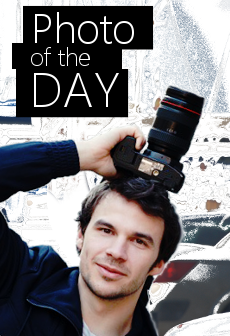An interview with Ernst Arnold Bauer by AnnMarie Rudin

Portrait of Bauer taken by Elisabeth Andrade
While studying in a Bavarian town called Eichstätt, I must have walked past the windows of an art gallery at least four times each day, running errands and dashing to classes. The colorful personality of the room within always attracted me, as did the charming artist who worked there.
My first impression of Ernst Arnold Bauer was a favorable one, for he always greeted me with warm smiles and enthusiastic waving. I was at first ever so hesitant to introduce myself, but becoming better acquainted with him, his story and his artwork has been an honor and pleasure.

Photo: Bauer’s Gallery in Eichstätt, Germany, taken by Stian Eipert
According to his professors at the Art Academy in Linz, Austria, where Bauer studied painting and drawing, he was easily the best in his class. The director of the art school hoped to see him become his successor at the Academy, but Bauer knew it in his heart that he wanted to become an artist. Supported by his parents, Bauer started painting as a little child, and with such artistic talent he was bound to succeed.
Upon graduation with honors in 1971, Bauer opened his first exhibition in Linz, which was very well-received. Thereafter he moved to Salzburg, where he continued to host exhibitions. Over the years, he has also displayed his artwork in distinguished revenues in Germany, the UK, and Bermuda. He occupied his time with his artwork and in searching for himself. Inspired by the German philosopher Schopenhauer, Bauer sought to overcome the misery in life. According to Bauer, introspection quickly becomes the stepping stone to discovering one’s self.
A spiritual aspect is clearly reflected in his works. He asked me rhetorically, but ever so seriously, to look around. He observes that the world is not in balance, and he remarks, “it makes you wonder why there is hate and hunger, this and that, all against human senses. You don’t want the world to be like this.”
He insists that there is a divine reason behind everything, and he asks what can be done to overcome all of this.
As an artist, he expressed to me great respect and admiration for wonderful artists, among whom he named Barnett Newman and Mark Rothko in particular, who have been some of the main figures in art nouveau and abstract expressionism. Bauer states that there is no need to imitate, but he feels connected to them.
“They all have the same desire: to achieve perfection in art and in themselves.”
It is not to say that an artist is restricted in whatever he does, but in the past 40 years of Bauer’s career, he has not changed his style once. Granting the images never repeat each other, there is a personable piece of commonality found in each work of art. Bauer explained that he could do whatever he wanted in his artwork, but they still reflect him. His artwork invites the viewer’s attention to the “same radiation.”
Bauer came to the beautiful, baroque city of Eichstätt thirty years ago.
“It is not the place itself that makes it holy, but it is the human being who lives there,” he reflected.
He feels comfortable there, and his alluring artwork and contagious personality are well-received by the university and the inhabitants.
On an ending note, Bauer refers to the renaissance of the aesthetics in explaining the importance of love, a story which I believe to be mirrored in his artwork.
“It’s all about love, which is the essence of our existence. Love is the only solution to overcome any misery of existence.”
On behalf of Ernst Arnold Bauer, I would like to invite you to browse his website to enjoy a selection of his paintings and drawings: http://art-pure.org/











1 comment so far ↓
Nobody has commented yet. Be the first!
Comment